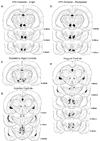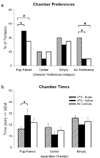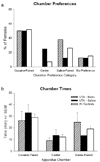Transient inactivation of the ventral tegmental area selectively disrupts the expression of conditioned place preference for pup- but not cocaine-paired contexts
- PMID: 20001116
- PMCID: PMC2828762
- DOI: 10.1037/a0017666
Transient inactivation of the ventral tegmental area selectively disrupts the expression of conditioned place preference for pup- but not cocaine-paired contexts
Abstract
The ventral tegmental area (VTA) plays a critical role in motivated behavior. However, it remains unclear whether intact VTA function is necessary for motivated behavior to seek contexts repeatedly paired with natural stimuli and/or pharmacological stimuli. In the present study, conditioned place preference (CPP) was induced with highly salient natural or drug stimuli attributed with strong incentive-motivational value in each of 2 female models: Postpartum females were conditioned to associate one unique context in the CPP apparatus with young offspring (pups) and a second context with a neutral stimulus, and virgin females were conditioned to associate unique contexts with cocaine (5 mg/kg ip) and saline injections. Immediately before CPP testing, each female received a microinfusion of bupivacaine bilaterally into the VTA to transiently inactivate the region; subjects were also tested after saline microinfusion into the VTA. Postpartum females' preference for the pup-paired context was abolished by VTA inactivation but was restored to high control levels after saline microinfusion. In separate tests, VTA inactivation also reduced motivated pup licking and pup retrieval in postpartum females, suggesting that intact VTA function is required for the expression of both pup CPP and motivated pup-directed behaviors. Cocaine CPP remained unaffected by VTA inactivation. Locomotion was not affected by VTA microinfusions but was severely impaired by bupivacaine microinfusions into the substantia nigra. We concluded that the VTA is differentially involved in the expression of conditioned preference for contexts paired with pups, a salient natural stimulus, and contexts paired with cocaine.
Figures







Similar articles
-
The medial preoptic area is necessary for motivated choice of pup- over cocaine-associated environments by early postpartum rats.Neuroscience. 2010 May 5;167(2):216-31. doi: 10.1016/j.neuroscience.2010.02.015. Epub 2010 Feb 12. Neuroscience. 2010. PMID: 20156528 Free PMC article.
-
Serotonin 5-HT2A and 5-HT2C receptors regulate rat maternal behavior through distinct behavioral and neural mechanisms.Neuropharmacology. 2020 Jan 1;162:107848. doi: 10.1016/j.neuropharm.2019.107848. Epub 2019 Nov 7. Neuropharmacology. 2020. PMID: 31706992
-
Incentive salience of cocaine across the postpartum period of the female rat.Psychopharmacology (Berl). 2008 Jul;199(1):119-30. doi: 10.1007/s00213-008-1140-9. Epub 2008 May 11. Psychopharmacology (Berl). 2008. PMID: 18470696 Free PMC article.
-
Lateral hypothalamic orexin/hypocretin neurons: A role in reward-seeking and addiction.Brain Res. 2010 Feb 16;1314:74-90. doi: 10.1016/j.brainres.2009.09.106. Epub 2009 Oct 6. Brain Res. 2010. PMID: 19815001 Free PMC article. Review.
-
Functional mapping of the neural circuitry of rat maternal motivation: effects of site-specific transient neural inactivation.J Neuroendocrinol. 2011 Nov;23(11):1020-35. doi: 10.1111/j.1365-2826.2011.02200.x. J Neuroendocrinol. 2011. PMID: 21815954 Free PMC article. Review.
Cited by
-
Oxytocin interactions with central dopamine and serotonin systems regulate different components of motherhood.Philos Trans R Soc Lond B Biol Sci. 2022 Aug 29;377(1858):20210062. doi: 10.1098/rstb.2021.0062. Epub 2022 Jul 11. Philos Trans R Soc Lond B Biol Sci. 2022. PMID: 35858105 Free PMC article. Review.
-
A Scientometric Approach to Review the Role of the Medial Preoptic Area (MPOA) in Parental Behavior.Brain Sci. 2021 Mar 20;11(3):393. doi: 10.3390/brainsci11030393. Brain Sci. 2021. PMID: 33804634 Free PMC article. Review.
-
Both high and low doses of cocaine derail normal maternal caregiving - lessons from the laboratory rat.Front Psychiatry. 2011 May 30;2:30. doi: 10.3389/fpsyt.2011.00030. eCollection 2011. Front Psychiatry. 2011. PMID: 21687771 Free PMC article. No abstract available.
-
Adaptations in reward-related behaviors and mesolimbic dopamine function during motherhood and the postpartum period.Front Neuroendocrinol. 2020 Apr;57:100839. doi: 10.1016/j.yfrne.2020.100839. Epub 2020 Apr 16. Front Neuroendocrinol. 2020. PMID: 32305528 Free PMC article. Review.
-
Thalamic integration of social stimuli regulating parental behavior and the oxytocin system.Front Neuroendocrinol. 2018 Oct;51:102-115. doi: 10.1016/j.yfrne.2018.05.002. Epub 2018 May 26. Front Neuroendocrinol. 2018. PMID: 29842887 Free PMC article. Review.
References
-
- Achat-Mendes C, Ali SF, Itzhak Y. Differential effects of amphetamines-induced neurotoxicity on appetitive and aversive Pavlovian conditioning in mice. Neuropsychopharmacology. 2005;30:1128–1137. - PubMed
-
- Afonso VM, Grella SL, Chatterjee D, Fleming AS. Previous maternal experience affects accumbal dopaminergic responses to pup-stimuli. Brain Res. 2008;1198:115–123. - PubMed
-
- Afonso VM, Sison M, Lovic V, Fleming AS. Medial prefrontal cortex lesions in the female rat affect sexual and maternal behavior and their sequential organization. Behav Neurosci. 2007;121:515–526. - PubMed
-
- Bardo MT, Rowlett JK, Harris MJ. Conditioned place preference using opiate and stimulant drugs: a meta-analysis. Neurosci Biobehav Rev. 1995;19:39–51. - PubMed

